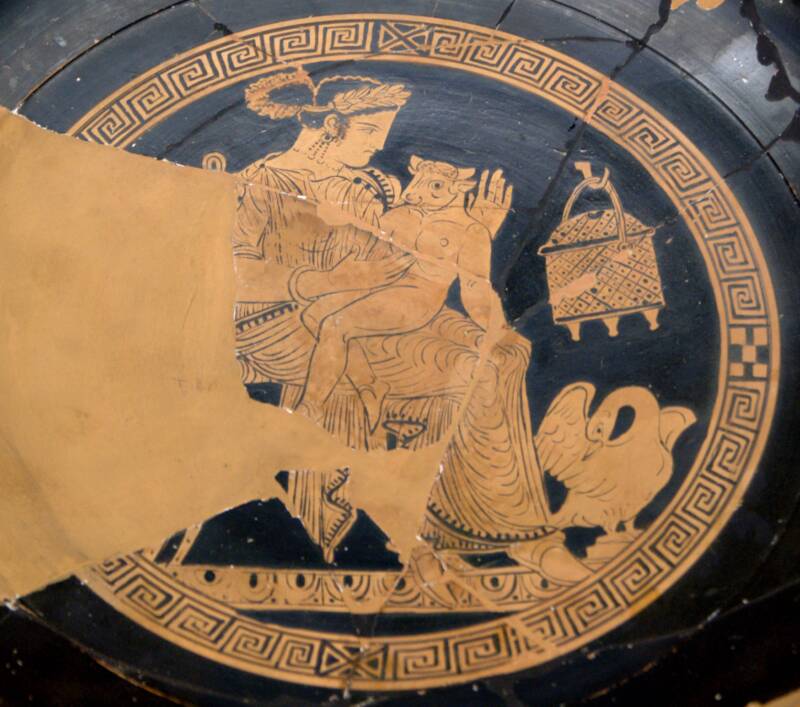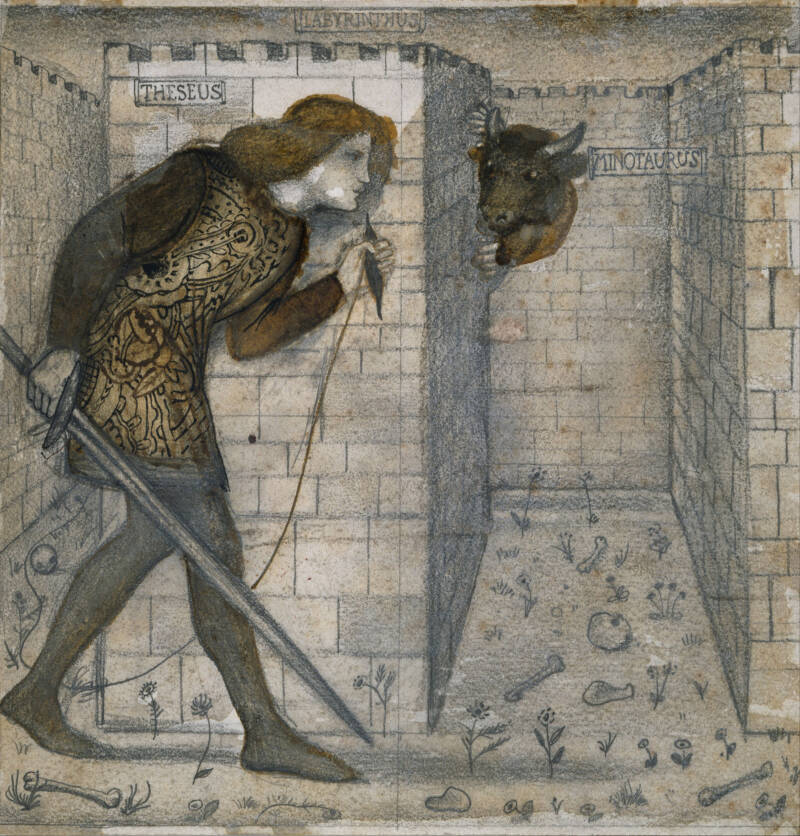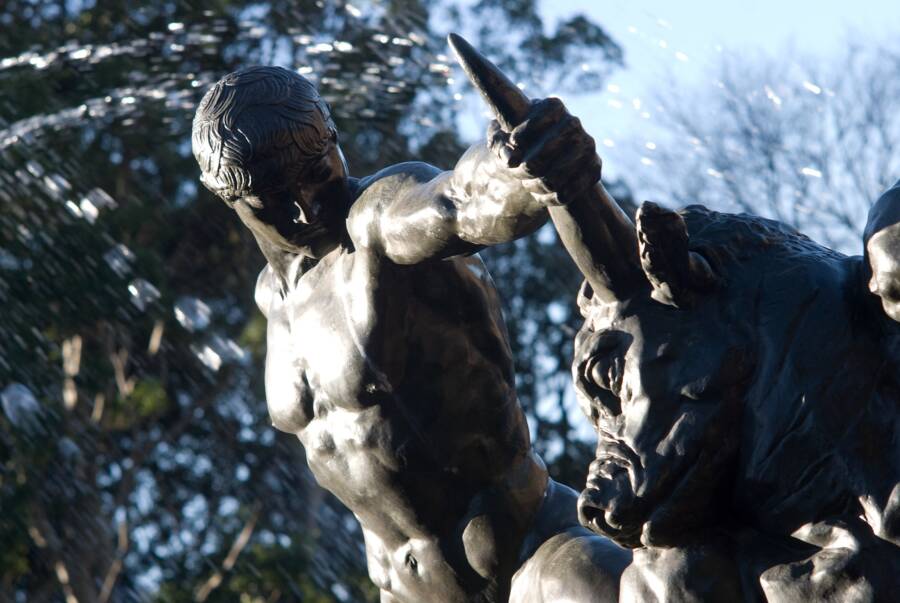One of the most disturbing creatures of Greek mythology, the Minotaur stalked the Labyrinth and feasted on human flesh — until he was killed by Theseus.

Marie-Lan Nguyen/Wikimedia CommonsA depiction of the Minotaur, created circa 515 B.C.E.
Greek mythology describes the Minotaur as a horrific monster who devours the flesh of youths and maidens. Although the creature has the body of a human, he sports the head and tail of a bull.
Deemed a memento of unnatural love by the Roman poet Virgil, the Minotaur was the offspring of a woman and a bull. As if that weren’t disturbing enough, the Minotaur was only born because a king named Minos had disrespected the gods. Chillingly, the king’s punishment was that his wife, Pasiphae, would be divinely forced into bestiality.
Clearly, the Minotaur was meant to be a frightening creature with an upsetting backstory. But was there a deeper meaning behind this beast? Here’s what we know about the Minotaur — and what he might represent.
The Disturbing Origin Story Of The Minotaur
According to Greek myth, the Minotaur was a half-human, half-bull monster created by the god Poseidon as a divine punishment.
In ancient Crete, King Minos secured his power over the region by praying for the gods to send him a bull from the ocean. He then promised he would sacrifice the animal to Poseidon, the god of the sea. But when Poseidon answered Minos’ prayer, Minos decided to keep the bull for himself.
Furious at the mortal king, Poseidon enchanted Minos’ wife, Queen Pasiphae. The god stirred an unnatural desire in Pasiphae for the majestic, white bull.
Consumed with passion, Pasiphae asked the craftsman Daedalus and his son Icarus to build a wooden cow so she could wear the disguise and seduce the bull. Their union resulted in the birth of the Minotaur.

Wolfgang Rieger/Wikimedia CommonsConsumed with passion sent by the gods, Pasiphae asked Daedalus to help her seduce a bull.
“This creature, they say, was of double form,” wrote the Greek historian Diodorus Siculus, “the upper parts of the body as far as the shoulders being those of a bull and the remaining parts those of a man.”
When the queen gave birth to the creature, King Minos flew into a rage. The unnatural birth proved his wife’s infidelity. But while Minos enslaved Daedalus and Icarus for helping Pasiphae mate with the bull, he did not punish Pasiphae, believing her claims that she’d been cursed. Surprisingly, Minos also allowed Pasiphae to raise the calf, whom she named Asterion.

Bibliothèque nationale de FrancePasiphae raised the baby Minotaur, whom she named Asterion.
Yet as Asterion grew older, he became violent and unpredictable. Caught between his human and animal natures, Asterion began to devour people.
In order to hide Pasiphae’s unusual “affair,” King Minos ordered Daedalus to construct the massive Labyrinth to hide the Minotaur away.
Inside The Minotaur’s Labyrinth
Some ancient tellings of the Minotaur myth blamed Pasiphae for the monster’s existence, even though she was clearly cursed.
“She did but pollute herself with her shameful lust,” wrote the Roman philosopher Seneca, “and yet her offspring by its two-shaped infamy displayed her crime, though long concealed, and by his fierce visage the hybrid child made clear his mother’s guilt.”
Because his very existence revealed the queen’s infidelity, King Minos declared that the monster with a bull’s head must live out the rest of his days in the Labyrinth, a huge maze that served as a prison.
Minos warned Daedalus to build a Labyrinth that no one could escape. “To rid his precincts of this shame the king planned to confine him shut away within blind walls of intricate complexity,” explained the Roman poet Ovid.

Kunsthistorisches MuseumHidden away in the Labyrinth, the Minotaur could not bring shame to King Minos.
Generations of artists have depicted the Labyrinth as a tangled web with endless paths. Even Daedalus struggled to escape the complex maze.
With the Minotaur hidden away in the Labyrinth, King Minos focused on ruling Crete and preparing his heir, Androgeos, for the throne. But Androgeos never returned home from an appearance at the Panathenaic Games.
It’s believed that either the Athenians killed Androgeos because they were jealous of his skills at the games or that the King of Athens ordered Androgeos’ death to stop him from winning any other competitions. Ironically, in the latter version, a bull was summoned to kill Androgeos.
In retribution, Minos demanded that the Athenians sacrifice seven Athenian youths and seven maidens each year, who would be sent into the Labyrinth for the Minotaur to consume. (Some versions of the legend say this sacrifice only occurred every ninth year.) The sacrifice would continue until one hero volunteered to go inside the Labyrinth willingly — to kill the Minotaur.
How The Legendary Beast Was Finally Killed
The first tribute of youths all perished in the Labyrinth. So did the second. But the Minotaur’s fate — and Greek history — changed the third time.
Athenian hero Theseus, the son of the King Aegeus, volunteered to join the young men and women heading to certain death in Crete. Confident that he could slay the beast, Theseus promised to return victorious.
When Theseus landed in Crete, he met Ariadne, a daughter of King Minos. Ariadne fell for Theseus and vowed to help him escape his fate.
Ariadne pleaded with Daedalus to tell her how to escape the Labyrinth. Eventually, Daedalus told her how to get out of the maze. With the solution in hand, Ariadne raced to tell Theseus before he was locked in the Labyrinth. All Theseus needed was a simple ball of thread.
When he entered the Labyrinth, Theseus tied the thread to the entrance, letting it trail behind him as he searched for the beast.

Edward Burne-Jones/Birmingham Museum and Art GalleryA 19th-century image shows Theseus stalking the Minotaur in the Labyrinth.
Eventually, Theseus discovered the Minotaur. He successfully slayed the monstrous creature — either with his fists or the sword of Aegeus — and triumphantly escaped the maze thanks to Ariadne’s thread.
The Legacy Of The Minotaur Myth
The Minotaur was one of many monsters and villains that Theseus defeated. The legendary hero also battled centaurs and boars, robbers and bandits.
But the death of the Minotaur became a defining myth in ancient Greece.
After defeating the Minotaur, Theseus returned to Athens triumphant — and abandoned Ariadne. But Theseus forgot the promise he’d made to his father to replace his ship’s black sails with white sails (white sails meant that he succeeded in his mission and black sails meant that he’d been killed). Seeing black sails on the horizon, Theseus’ father died by suicide.
Theseus thus became the new Athenian king and established the city as a powerhouse in ancient Greece. Tales of Theseus’ victories became metaphors for Athenian dominance. Regardless of the challenge, Athens would surely succeed, just like Theseus in the Labyrinth.

Graham Crumb/Wikimedia CommonsFor centuries, Theseus has been celebrated as a hero, while the Minotaur has been derided as a monster.
Was there any other meaning behind the myth of the Minotaur and his death? Some experts have theorized that the legendary slaying of the Minotaur by the Greek hero Theseus might symbolize the liberation of ancient Greece from the Minoan Crete. After all, the Minoan Crete had once dominated the region, and they were believed to have revered bulls.
Others have suggested that the mythical creature may have represented the worst qualities of Greek gods and rulers, since the Minotaur’s very creation was Poseidon’s way of punishing King Minos for his disrespect.
Ultimately, the tale of the Minotaur reveals a lot about ancient Greece and the values of the people who lived there. Many believed that a monstrous appearance was linked to a monstrous nature. Women were often cast into secondary roles in stories, even when they acted heroically. And the gods could be capricious — willing to destroy a family just to prove a point.
After reading about the Minotaur, learn about the disturbing Greek myth of Hades and Persephone. Then, check out history’s creepiest cryptids.





